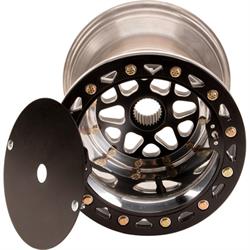Wheel Offset Explained
Do you have various options for wheel sizes and offsets in your trailer? If so, how do you determine when to run each variation? In this article, I am going to help you better determine which wheel offsets to select, and when to change them.
Utilizing different wheel offsets can be useful in determining setup for different track conditions, so it is important to understand what is happening when you change it. Think about where the wheel center is in relationship to the tire. The position of your wheel center will determine where the weight of your race car is being applied to the tire. When using this to your advantage, you can use various wheel offsets to manipulate your tire.
For instance, the deeper the offset or further out the wheel center is in relation to the tire, the more side wall deflection you generate with the tire due to weight being applied further outward on the tire. Running a deeper offset can be useful for slick track conditions when looking for more grip or “side bite” through the corner. Running a shallower offset will reduce side wall deflection allowing the car to rotate freer, which would be more beneficial in a heavy or rough track condition.
When taking advantage of this theory, you will be enabled to find more consistency in the feel of your car. For example, some may adjust or reduce tire pressure to find more grip or “side bite” when the track is slick. By changing a wheel offset instead, you will be able to run more consistent tire pressures and when you do decide to adjust them, it can be a less drastic adjustment. Some also adjust wheel spacing to try and tighten or loosen the car up for any given track condition.
What many don’t realize is that changing wheel spacing will also affect your roll center and center of gravity. It is not wrong to change spacing; however it can have a more radical impact on the handling of the car. This can create a period of the race where the driver has to feel the car out first before he/she can race at 100% due to a new feel in the seat caused by a roll center and center of gravity change.
By leaving wheel spacing the same, these variables are no longer in play, leaving consistency in the feel of the car for the driver. By simply changing a wheel offset instead, you are now manipulating the amount of grip you get out of that tire and you can easily make an offset decision according to track conditions.
To help paint a better picture, I will use my race car as another example. On hand, I always keep three different options for right rear wheel offsets in my trailer. All three options are the same width, just various offsets built into each wheel. I have the Aero-Dynamics Racing Wheels 10 x 12” Beadlock, 5” Offset. I have a 10 x 12” with a 6” offset, and the Aero-Dynamics Racing Wheels 10 x 12” Beadlock, 7” Offset.
I typically start a race evening with my 5” offset because I know a freshly groomed track will have plenty of moisture to start, creating plenty of grip in the racing surface. As track conditions change and the track gets wider, I switch to my 6” offset. The 6” offset is probably my most frequently used rim and works well in most track conditions.
Lastly, if the track is a sheet of glass, or extremely slick with minimal moisture to find, I will run the 7” offset. Effectively, I can control the amount of grip I have with the right rear tire by adjusting a wheel offset all while maintain consistency and balance in my setup because all other changed being made to the car are minimal if at all.

